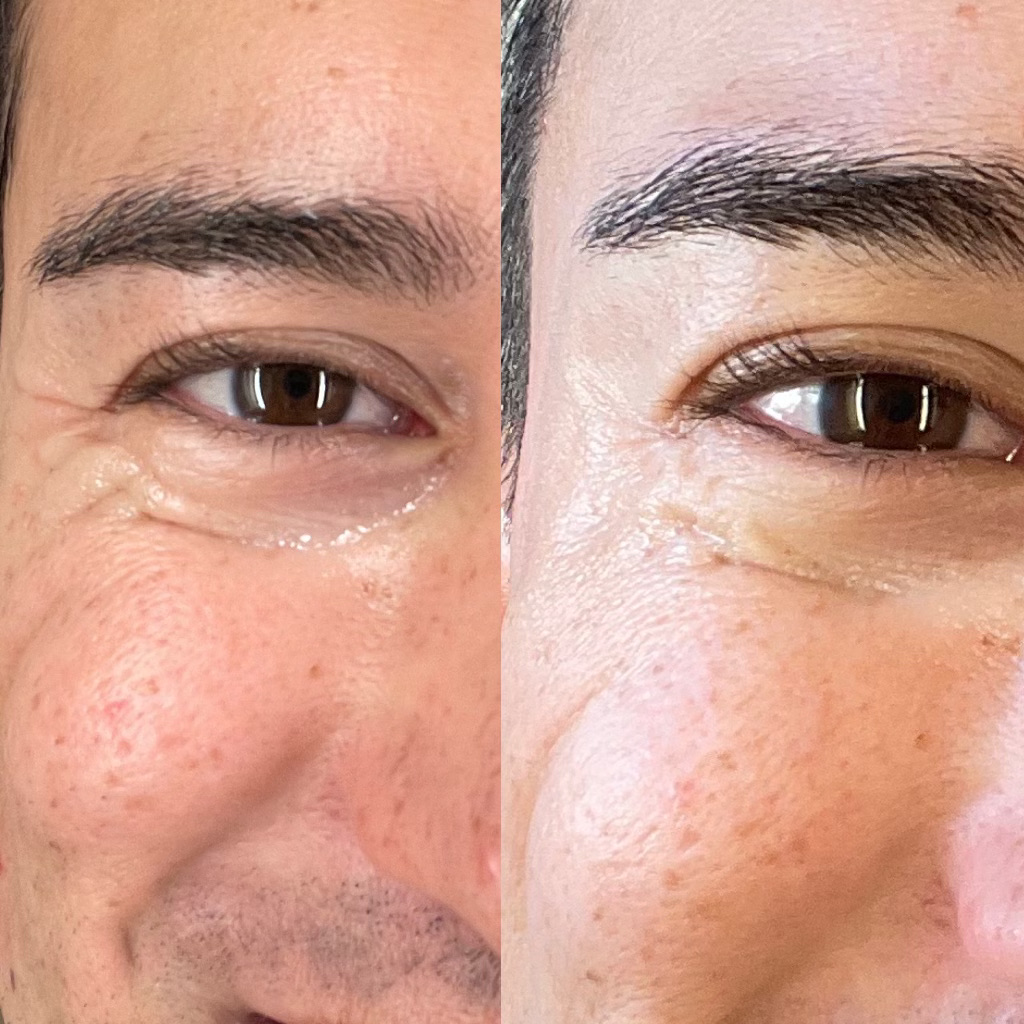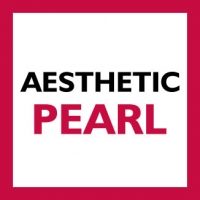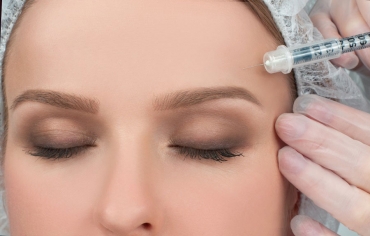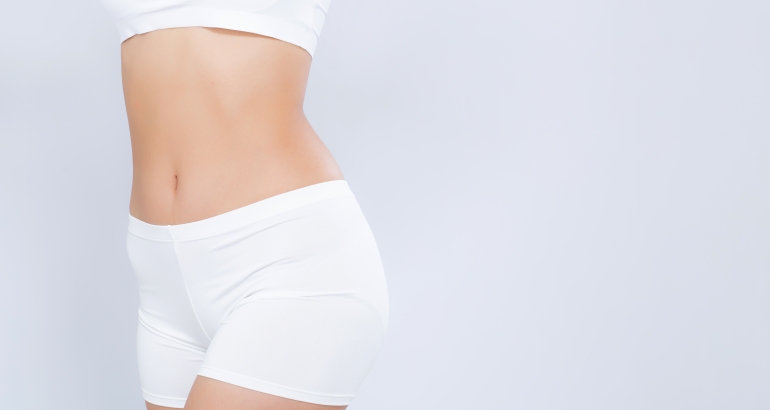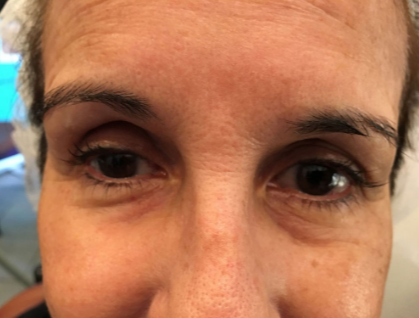Anti-Aging with Injectables
Botox:
What is Botox?
Botox (Onobotulinum toxin A) is the most common anti-aging neurotoxin used to reduce wrinkles such as crow’s feet, frown lines, smile lines, and forehead furrows. Botox is extremely effective in adults of all ages to reduce dynamic lines (facial lines with expression, movement) and prevent deepening of furrows. Botox is also used to prevent new wrinkles from forming and improve lines at rest. Botox weakens the muscle’s ability to contract, which reduces wrinkles and lines resulting in an improved facial appearance. Multiple tiny injections are placed strategically into the facial muscles responsible for movements that are associated with wrinkles and lines. With time, repetitive muscular action tends to deepen facial lines. Wrinkles result from a combination of many factors: cells age over time, collagen and bone reduce every year, and skin damage by free radicals in the sun and environmental pollution. Botox therapy has been an extensively studied cosmetic procedure used by men and women all over the world. Millions of vials of Botox are used in the US to temporarily reduce muscle activity. Botox contains tiny amounts of a highly purified botulinum toxin protein. Hundreds of clinical trials in peer-reviewed scientific and medical journals confirm the safety and effectiveness of Botox. Inform us of your past reactions and tendencies with the use of Botox. Our office orders from the company Allergan, which has produced millions of vials of this highly purified neurotoxin protein. For patients who prefer Dysport, we order from their manufacturer, Galderma.
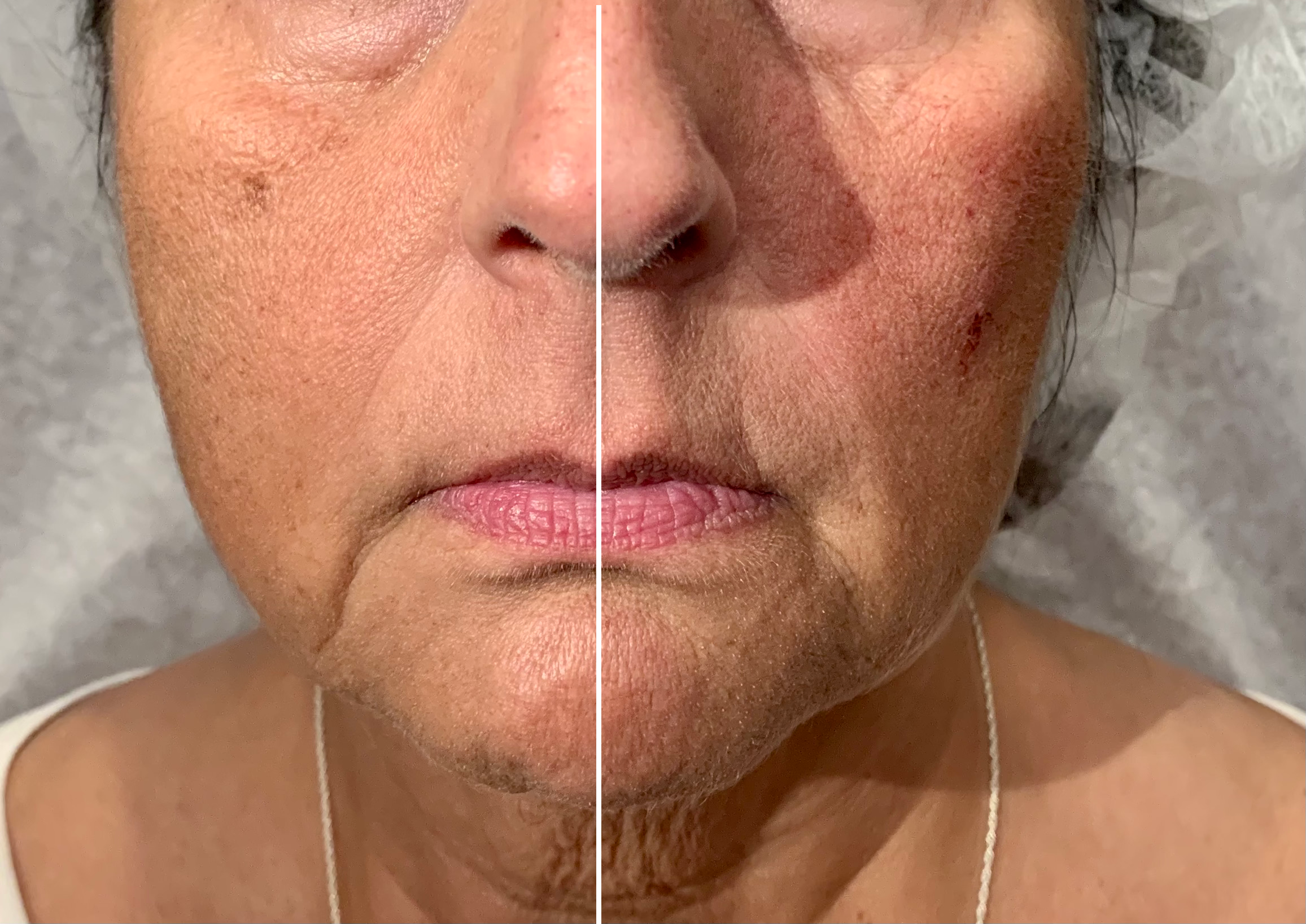
Photo shows — “compare and see improvement on the Left side of the face” Filler into the mid-face improved her anterior facial projection which lifts and contours the left side of her face. Filler into her Lower face corrected and lifted her downturned mouth corners, and got rid of her marionette lines to the chin.”
How long does Botox last?
The amount of Botox needed and frequency of treatment is tailored individually, and repeated every 3 to 5 months to continue the desired effect. Different areas of the face have different speeds of neuro-muscular repair. Age and genetics affect individual responses to Botox. It is best to space your next treatment before all the effect has worn off. Since Botox is an elective procedure, you may discontinue anytime.
Prep Before Botox:
We ask patients to avoid taking aspirin or NSAIDS and blood-thinning supplements like fish oil for 1 week before Botox injections to reduce the risk of bruising. Our needles are so tiny, that most patients do not need any ice or topical numbing cream before injection. Our team will analyze and determine the exact amount and ideal placement for your desired results. Patients tolerate treatment very well and may only feel a slight pinch. Treatments take less than 10 minutes and most patients resume their normal day. If you are having other energy-based skin rejuvenation on the same day, Botox will be given at the end of your session.
How Botox Feels:
You can immediately go back to your daily routine. Injected Botox starts to work in days to gradually relax nerves that cause muscle contraction; some will notice a less tired appearance. It takes a full 10 to 14 days to appreciate a final expected smoother facial result. The injections on the forehead and around the eyes are the most superficial and show as little wheals like “mosquito bites” at the sites of injection for less than 30 minutes before they absorb and diffuse. Injections into thicker muscles may need a little gentle pressure held for a few minutes. Expect minor swelling or redness at the injection sites that usually resolves within the hour. We ask every patient to text or have a follow-up appointment 2 weeks after treatment. Reviewing your results allows us to tailor future treatments or perform a complimentary touch up if needed. Responses do vary and there are no guarantees as to the expected results.
AFTERCARE INSTRUCTIONS for BOTOX or DYSPORT
Aftercare Instructions for optimize results, reduce bruising and unintended spreading:
- There is no recovery time, so you may continue a routine relaxing day. Some skin areas will have small wheals of the medication that self-resolve in less than 30 minutes.
- No strenuous exercise the same day after injections
- Apply Sunscreen gently and avoid direct sun for 4 hours
- No facial massage for 24-48 hours after Botox or Dysport
- Do not wear a tight hat or cap that would compress the injected area
- Avoid excessive alcohol the day of treatment
Precautions recommended but not required after treatment:
- Avoid lying down to sleep for 3-4 hours after injections
- Avoid exercise or alcohol for 24 to 48 hours after injection with neurotoxin especially if you have a history of rapid metabolism
- Avoid makeup, sun, or heat (hot showers or baths, saunas, tanning beds) exposure until the next day
- Avoid medications and supplements that are blood thinning and might increase bruising (NSAIDs, fish oil)
- Transient mild swelling and redness is normal. Inform us you have a bruise; we can perform a light treatment in the office at no charge to resolve it more quickly.
Follow-up:
- After injection into the targeted muscles the effect gradually begins in a few days but take 10-14 days to see the final result. You can call or text us anytime after treatment with any concerns.
- Especially for new patients, or after a new injection pattern; we request that you return in 2 weeks to confirm results and optimize your treatment plan.
- Additional units of neurotoxin may be given at anytime; preferably after 2 weeks, to achieve the desired result.
- Patients usually return every three to five months to maintain their results. Please hold an appointment every 4 months for a year as a reminder and adjust the date and interval as needed.
Fillers:
At Aesthetic Pearl, we have experts in filler procedures. Fillers are a non-surgical wrinkle treatment and volume replacement. Fillers replace volume, especially under the eye, cheeks, or lips. Topical and local numbing help make the injections more comfortable. The number of various fillers used depends on the depth of the wrinkles and is individualized to your preference for a more natural or enhanced appearance. You will have swelling and temporary redness around the injection sites. The doctor will often massage the area after injection to spread and contour. Results may last anywhere from four months to two years.
Filler Aftercare Instructions
- What to Expect Afterwards:
- If you have swelling in the area, an ice pack may be applied (Do not use blue ice). Apply covered ice for 5 minutes, then leave off for 10 minutes, repeat the cycle as long as needed for your comfort.
- Swelling especially after lip filler is expected. In 1-2 days, the extent will reduce greatly, and be at baseline in 4-7 days. Inform us if swelling is excessive. Patients with a tendency to bruise and swell may take OTC preventative medication (oral Arnica montana).
- Mild injection site reactions are normal; the injection site may be tender after the lidocaine has worn off.
- Lumpiness and bumps are normal, and can be molded or allowed to self-resolve over the next few weeks as the Filler settles in. We rely on how it looks; some areas will contain more product to create visual symmetry.
- Redness, mild discoloration and itching can occur and should self-resolve in days to 2 weeks. If you notice bruising, you are welcome to come for a complimentary “light treatment” to help resolve the discoloration much more quickly.
- AVOID:
- strenuous exercise the day of the procedure
- excessive sun, heat or cold exposure for the next 48 hours
- Keep your face clean to reduce the risk of infection
- For 7-10 days after a Filler treatment avoid: Aspirin, NSAIDs (ie: Advil, Motrin, Ibuprofen), Vitamin E, Fish Oil, Supplements of concentrated: ginger, ginseng, ginkgo, garlic, kava, celery root or excessive alcohol.
- WAIT:
- 12 hours after the procedure to apply make-up (use clean, or new applicators and products)
- 24 hours before resuming your facial skin care routine (use clean, or new applicators and products)
- 2 weeks before: any Dental Procedures, facial massage or tight goggles
- Continue:
- sun protection with a hat, sun glasses and sunscreen lotions
- Continue your preventative Valtrex (or other anti-viral) medication for 1 to 3 days if you tend to break out in lip sores with any lip Filler treatment or stimulating trigger.
- Make a Follow-up visit in 4 weeks:
- Call us if you have unusual pain, bruising or concern.
- Every patient of ours are to contact us on our cell numbers. Confirm that you have the cell# contact for your nurse/nurse practitioner and Dr. Yee.
- For non-urgent questions, feel free to text us or email at aestheticpearlmd@gmail.com.
The average “Filler treatment” in the standard studies used an average of 4.8 ml for initial treatment. In our practice, we commit to using the least possible amount of filler product for the desired result. We recommend gradual treatment in steps, especially if multiple areas need enhancement. With careful feedback and communication; we can individualize and safely achieve your desired aesthetic result.
Dermal Filler Patient Information
What is a “Filler” or Dermal Filler?
A ”filler” is a clear injectable gel composed of hyaluronic acid (HA) that is placed underneath the skin to smooth a wrinkle or fold, restore fullness or volume and lift or contour the facial area. HA is a naturally occurring polysaccharide (sugar), found in the human body that gives the skin moisture, volume, and elasticity.
Synthesized HA is processed to form a network of crosslinking which makes it lasts longer than the HA that naturally exists in your body. Most HA fillers contain 0.3 % lidocaine to reduce discomfort during injection. A very limited number of companies produce FDA approved products. We prefer the Juvederm family of Fillers made by Allergan. Different types of fillers are placed more deeply over the bone, some are in the soft tissue and some are just under the skin. Dermal fillers are placed using an ultrafine needle or with a small blunt-tipped cannula, depending on the location of placement and type of product used.
What happens during the procedure?
Your skin will be cleansed prior to treatment with one or all of the following: chlorohexidine, puracyn, alcohol and possibly a mouth rinse. If treating the lips, a topical anesthetic is applied before treatment, and ice can be applied before and afterwards if desired. More than one entry will be made to layer the product and allow the anesthetic (lidocaine) to become effective. The primary goal of filler is to improve your healthy and more youthful appearance from various angles. The visual effect may be immediate and very dramatic or subtle to the untrained eye. A varying amount of palpation and some molding may be used. A pause to alternate sides is usually taken during treatment to allow the lidocaine to take effect, which reduces the discomfort. Do understand that faces naturally never have perfect symmetry. We will have you observe and comment on the filler effect, before the completion of the filler treatment. The filler will continue to adhere and hydrate into the space it is placed over the next 2 to 4 weeks.
What to expect:
Our goal is to strategically place the filler for the greatest results and benefit. We encourage adding filler as needed, in steps, for a natural appearance and to utilize the least amount of product. Being able to feel the filler is natural for several weeks and will become less noticeable as the weeks progress. It is common and expected to have different feeling filler on each side of your face, since the primary goal is the external appearance. Adjustments and removal of injected filler can be performed at any time after a filler placement. However, reversal is uncommon with our conservative approach. Avoid touching the treated area for six hours after treatment to avoid accidental skin injury while the area is numb. After the numbing has worn off, you may gently wash your face. Avoid: aspirin, NSAID, St. John’s Wort, blood thinners, and high doses of Vitamin E supplements for one week after treatment.
Follow-up:
You can return any time but ask for all patients to return in 1 month to follow-up results and document individual preferences. The most common temporary effects from an injection are: redness, bruising, inflammation, bumps, pain, swelling, itching, or hardening and may last for hours, but usually self-resolve by 2 weeks. Please refer to the “Consent for Botox and Filler” form for detailed information regarding side effects, risks, complications and alternatives.
Patients should not use a filler if:
- You have a history of severe allergic reactions, or have multiple severe allergies especially to bee stings.
- You have previous experience with allergic reactions to HA fillers.
- If you are allergic to lidocaine, we can discuss options.
Plasma Autologous Filler
“Natural Filler”
What is a “Natural Filler”
“Natural Filler” or “Plasma Autologous Filler” is completely made from your own blood, natural and organic. A simple intravenous collection in the office is needed to create the “Plasma Gel Filler”. You can utilize this organic or natural Filler anywhere a synthetic Filler is placed.
How is it made?
During the process to make PRP (Platelet Rich Plasma) for hair and face/neck rejuvenation and restoration, “PPP” (Platelet Poor Plasma) is produced. The “PPP” portion of your blood is utilized to make this natural and organic filler using the Bio-Heat device. “PPP” serum is rich in albumin and fibrin; which after thermal processing in the Bio-Heat, becomes the gel matrix.
How long does it last?
The Plasma Autologous Filler lasts for 3 months. Studies are limited, but several reports state that Plasma Autologous Filler lasts for 3-6 months, or longer when used in conjunction with PRP injections in the same area.
How much does it cost?
We add an additional cost of $300 to $500 to your PRP charge to make and administer Plasma Autologous Filler depending on the number of areas to be filled.
Before and After
